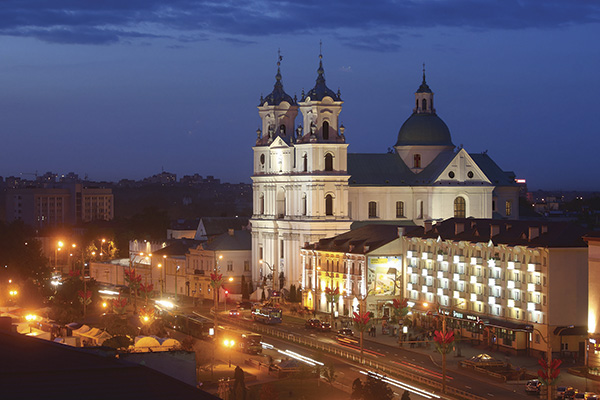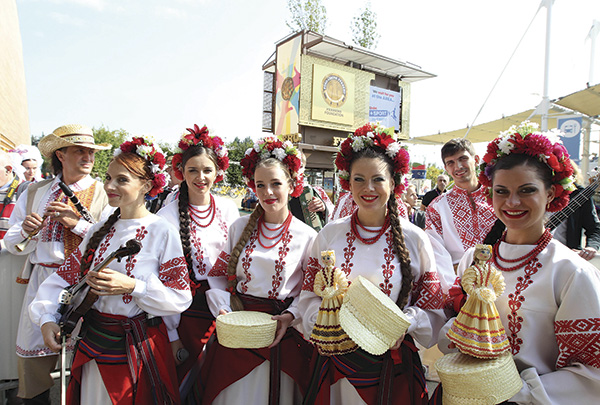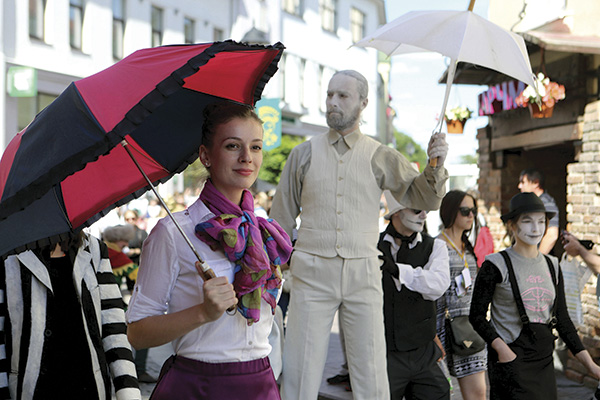
Minister of Culture of Belarus, Boris Svetlov, noted, “The draft Code of Culture, which has been worked on for a long time, was adopted during its first reading at the end of 2015 and will be finally approved this year. In my opinion, the ‘Castles of Belarus’ state renovation programme has been successfully implemented. 2015 was also marked by many successful premieres of performances and films. The Yanka Kupala State Academic Theatre premiered ‘The Seagull’ which was then taken to Moscow. The theatre has also created another performance, ‘World War II’, dedicated to the 70th anniversary of the Great Victory. ‘The Little Prince’ ballet, created by Belarusian composer Yevgeny Glebov three decades ago, was staged at the National Academic Bolshoi Opera and Ballet Theatre. Opera singer, mezzo-soprano Oksana Volkova became the first Belarusian to open the recent season at the Metropolitan Opera in New York. Moreover, an exhibition of works by Goya and Picasso at the National Art Museum was also unveiled late in the year.”
Other cultural events of 2015 recognised the 70th anniversary of the victory of the allies over Nazi Germany in World War II. Out of respect to the many victims lost by Belarus during the war, much has been done to commemorate the memory of our forefathers who fought for the freedom and independence of their Fatherland.
Memorial Gates unveiled at Trostenets Memorial Complex
Together with Khatyn, Trostenets is a symbol of one of the greatest tragedies of the 20th century, a place of national and universal remembrance for the victims of Nazi genocide. Back in 2014, a site improvement programme was launched. On June 22nd, with the President attending, the Memorial Gates Monument, sculpted by Konstantin Kostyuchenko, was unveiled. New memorial plaques will be added to the Trostenets Memorial Complex in the coming years under the guidance of architect Anna Aksenova. A Memory Road has been also laid up to the Gates, with granite signs commemorating the places where the deaths occurred.
Monument sited in Volozhin at the place of the 1942 massacre
On July 2nd, a memorial plaque to commemorate residents of the town, shot here in 1941-1942, was unveiled in Volozhin, at the former stadium, between Belorusskaya and Naberezhnaya streets. In 2014, the remains of 107 people were unearthed here during construction. A monument to ‘The Mourning Mother’ has been in place since 1961, a testament to the victims of fascism buried here. A plaque is situated close to the symbolic figure, reading: ‘To the memory of peaceful residents shot by the Nazis in 1941-1942’. The new memorial on the site of the tragedy has been unveiled thanks to the efforts the editorial office of the ‘Sovetskaya Belorussiya’ newspaper.

Renovated ‘Partisans’ mosaic on Tourist Hotel building in Minsk
Alexander Kishchenko’s ‘Partisan Belarus’ mosaic has once again appeared on Minsk’s Tourist Hotel. It’s symbolic that the author’s son took part in its restoration. He works in the Belrestavratsiya workshops where more than half of the original work was restored. The mosaic pattern was saved by a team of professionals, headed by scientific leader Alexander Klimashonok. The mosaic was created in 1973 and is registered on the State List of Objects of Historical and Cultural Value.
Belarusian folk art introduced in St. Petersburg and Voronezh
The exhibition ‘Belarusy.by’ displaying material from the ethnographic research of Belarus in the 20th century has opened in St. Petersburg. The exhibition hall accommodates five hundred exhibits including traditional Belarusian costumes, tableware, and musical instruments from the collection of the National History Museum of Belarus. “In order to understand these people and their traditions, it is necessary to know how they lived, what they wore, and how they celebrated,” said Oleg Ryzhkov, the Director of the Museum. Last year’s cultural capital of the CIS, Voronezh, saw the exhibition ‘Art of Belarus: through the Ages’, sent by the Museum of Ancient Belarusian Culture. Its Director Boris Lazuka described how, in this new collection, Russians will see many things that were saved from churches during the time of destruction. They will also be able to admire several examples of the 18th century Slutsk sashes, worn by priests and gentry at that time. These are highly decorated and brightly coloured objects with significant cultural value. They are accompanied by examples of more commonly worn rural clothes, tableware and other everyday items.”
An exhibition of Slutsk sashes has arrived in Minsk from Warsaw
Ewa Orlinska-Mianowska, the curator of the collection of fabrics of the National Museum of Poland, brought six sashes made in Slutsk in the 18th century, to the National Art Museum. Poland’s archives and museums possess 59 examples of these traditional national symbols of Belarus. In common with Belarussians, the sashes are also seen as part of the national heritage of Poland, as they were made and used at the time of the Rzecz Pospolita, a state occupied by both our nations. Ewa Orlinska-Mianowska explained in more detail, “Scientists call these belts ‘kontuszowy’ (‘kontusz sash’), as people belted kontusz and żupan, men’s wear. They were not only produced in Slutsk. To begin with, they were woven in India, Turkey and Persia (Iran). Manufacturing was even established in Venice in Italy and Lyon in France.” The Slutsk factory was founded by Jan Madjarski in 1767 with the backing of Karol Stanisław ‘Panie Kochanku’ Radziwiłł. Workers were chosen from the local residents. In the first ten years Yan Madzharsky made 758 of these highly prized decorated sashes.

Restoration work carried out on medieval castles
In January 2011, the Council of Ministers adopted the state programme Castles of Belarus. It is expected to end in 2018 when 38 sites will have been restored. Experts of the institute Grodnograzhdanproekt and research supervisor Vladimir Bochkov are engaged in engineering research and the design of the first stage of restoration of the Old Castle in Grodno. Since 2003, works to restore towers and walls of the castle have been taking place in Lyubcha. Volunteers from Belarus and abroad are participating in the programme of renovation. Plans for the preservation of 3 towers of the castle in Novogrudok are underway. As for the castle in Krevo, restoration is expected to start this year. According to Galina Balinskaya, Head of the Department of Ideological Work, Culture and Youth Affairs of Oshmyany District Executive Committee, the restoration of the northern tower of the Sapega Palace in Golshany has also begun this year.
Archaeologists add to knowledge of the oldest church in Polotsk
Up to now, it has been assumed that the most ancient church in Belarus is the Transfiguration Church in Polotsk. It boasts not only the remains of 12th century walls, but also frescos dating to the period inside the church. However, recent excavations have changed experts’ opinions about the initial shape of the church. It appears that it was considerably larger than we see it now. Denis Duk, Head of the scientific expedition and Polotsk State University’s Pro-rector responsible for Educational Work and Yevgeny Torshin, from St. Petersburg Hermitage Museum, told us about the discovery. They revealed that on both sides of the current construction there were galleries, and in front of the main façade, an extension, which considerably increased the size of the building.
During excavations, the scientist struck lucky on more than one occasion. In a crypt to the right of the main entrance they found the seal of Saint Yevfrosiniya Polotskaya, one of the foundresses of the church and monastery. The Ministry of Culture is considering how to work with the Russian restoration team to uncover more details of the ancient church help to keep this architectural masterpiece for us and our descendants.
Open-air archaeological museum created in Belovezhskaya Pushcha
Soon we will have more options when visiting Belovezhskaya Pushcha. As well as the aurochs and Father Frost, it will be possible to see how our ancestors lived in 2016 B.C. Scientists from the Institute of History at the National Academy of Sciences are carrying out excavations and will create an open-air archaeological museum in the national park, the first such museum in the country. One of the designers is Vadim Lakiza, Deputy Director for Scientific Work at the Institute of History. It appears that not only the auroch reigned in the pushcha, as archaeological sites showing settlements from many different eras have been discovered here.
Icons from iconostasis of Zhirovichi Assumption Cathedral displayed in the National Art Museum
It’s been five years since Alexander Yaroshevich and Yelena Karpenko, experts from the National Art Museum, went to the ancient Zhirovichi Monastery in order to remove precious icons as agreed with the Belarusian Orthodox Church. They were taken off the iconostasis (screen) established in the church in 1732. They are now at home in the National Art Museum and, for the first time since the 18th century, we can see these masterpieces, albeit at arm’s length. In their previous original setting they were at some considerable height and were mostly inaccessible, unlike their present setting.

International festivals of medieval culture held in Mstislavl and Golshany
On Zamkovaya Hill in Mstislavl, on the border with Russia, one could watch duelling knights, while the streets of the former capital of the kingdom were filled with craftsmen and culinary experts from all over the country demonstrating their skills. This is the second year that the festival of medieval culture has been held here. In Mstislavl, the celebration is also an occasion to see the 18th century Catholic Church of the Assumption of the Blessed Virgin Mary and other architectural monuments. This year the festival will again take place both in Mstislavl and Golshany, where knights and tourists gather together every year. In 2015, the festival celebrated the 735th anniversary of the city’s first appearance in the historical chronicles, 610 years since the birth of Sofia Golshanskaya, ancestor of the Polish-Lithuanian royal Jagiellonian dynasty, and 405 years since the construction of the Sapega palace which was described as ‘the black castle’ in the famous detective novel by Vladimir Korotkevich.
Belarusians, Lithuanians and Poles celebrated the 250th anniversary of Michał Kleofas Ogiński and the 145th anniversary of Ferdynand Ruszczyc
The 250th anniversary of the composer Michał Kleofas Ogiński, celebrated in 2015, was given particular attention by Belarusians. The estate of the musician in Zalesie was restored, while diplomat and collector Piotr Kravchenko, donated copies of 4 documents from the late 18th — early 19th centuries to the restored estate which has now become a museum. He bought the originals of these documents at auction. The final part of the celebrations took place in Minsk. The National History Museum introduced a goblet which once belonged to Bogdan, the grandson of the musician. It is one of the few original objects which relates to the noble family, and is still held in our country. The silver goblet made its way to Minsk from Rietavas in Lithuania where the estate of Bogdan Ogiński was situated. Wherever Ferdynand Ruszczyc worked, in St. Petersburg, Krakow, Warsaw, Vilnius, he always returned home to Bogdanovo, a village in what is now the region of Volozhin. The landscapes of one’s native village and its vicinities often produce the best creative work by the artist, whose 145th anniversary at the end of 2015 was celebrated by Belarusians, Lithuanians and Poles for the first time together in Bogdanovo. After all, each of the three people are united in considering Ruszczyc as their own artist. Until recently, Belarus had just one work by the painter, ‘Near Church’. The Director General of the National Art Museum, Vladimir Prokoptsov, has curated the first album in Belarus with the works of Ruszczyc. The most important thing, Prokoptsov reminds us, is to restore the estate of the artist in Bogdanovo. Tourists can soon appreciate a new cultural centre on the former estate and restoration works are planned for this year.
The country also acquired original works by Walenty Wańkowicz, Léon Bakst and Kazimir Malevich
Walenty Wańkowicz is the 19th century artist who was born near Minsk and whose life was closely connected with the city. Until recently, Belarus had no examples of works by this master painter. A portrait of the writer Tomasz Zan painted by the artist was brought from St. Petersburg, experts had been unaware of the existence of the work which now belongs to the corporate collection of Belgazprombank, and is stored in the National Art Museum. Belgazprombank has also purchased four of Léon Bakst’s works from collectors in Russia and Great Britain; they were bought for the bank’s own corporate collection. 150 years since his birth, the master painter will be celebrated in 2016. Since 1994, the picture of Kazimir Malevich has hung in the New castle of Grodno but there remains a question mark over the artist. The Director of the Grodno State Museum of History and Archaeology, Yuri Kiturko, is in no doubt however, that the picture of a man with a shovel painted on veneer is the work of the well-known artist, who worked with Marc Chagall in Vitebsk.
The first cards devoted to Belarusian places of Vilnius were issued
The complete set of cards ‘Vilnius-Vilnya. The Capital of Lithuania in the History of Belarus’ was issued by Minsk’s Riftur Publishing House. These are the first cards in the Belarusian language, devoted to Vilnius and its sights. Vilnius is the city where the first Belarusian books were printed in the early 16th century by Frantsisk Skorina. Here, at the beginning of the 20th century, the first Belarusian newspapers were published and the first Belarusian schools opened. The set of cards depicts 10 buildings connected with the lives and activities of well-known figures of Belarusian, Lithuanian and Polish culture in this ancient city.
* * *
In the Year of Culture there are plans to celebrate the 25th anniversary of the ‘Slavianski Bazaar’. Another significant date is the 75th anniversary of the birth of Vladimir Mulyavin. There will be many more anniversaries of writers such as; the 95th anniversary of Ivan Shamyakin’s birth, the 120th anniversary of Kondrat Krapaiva, the 125th anniversary of Maxim Bogdanovich. Preparations for events devoted to the anniversaries of Yanka Kupala and Yakub Kolas which we are to celebrate in 2017, will be carried out throughout the year. This year will see approximately 60 international festivals and Belarusian Days of Culture all around the world in places as far apart as Russia, Laos, Vietnam, Turkey and Venezuela. Similar days of culture for Armenia, Moldova, Latvia, Estonia and Pakistan are planned in Belarus. Cultural co-operation with China is being actively developed. An exhibition of Belarusian Orthodox and Catholic icons is being prepared in the Vatican. Finally, the reconstruction of the Belarusfilm film studio will be completed. New monuments will be opened under the state renovation programme ‘Castles of Belarus’. 2016 will become the year of the popularisation of Belarusian art.
By Viktar Korbut











